
Mu1 Cancri, Latinised from μ1 Cancri, is a variable star in the zodiac constellation of Cancer. The name Mu1 comes from the Bayer naming system: the "1" in the name is because (from Earth) it appears to be close to 10 Cancri, or Mu2 Cancri. It is also known by the variable star designation BL Cancri. The star is dimly visible to the naked eye with an apparent visual magnitude that ranges from 5.87 down to 6.07. Parallax measurements put it about 630 light-years (192 parsecs) from the Sun. At that distance, the visual magnitude is diminished by an extinction factor of 0.28. The position of the star near the ecliptic means it is subject to lunar occultations.

15 Cancri is an α2 CVn-type variable star in the zodiac constellation of Cancer, located around 980 light years away. It has the variable star designation BM Cancri ; 15 Cancri is the Flamsteed designation. This system is visible to the naked eye as a faint, white-hued star with an apparent visual magnitude of about 5.6. It is moving away from the Earth with a heliocentric radial velocity of 25 km/s.

38 Cancri is a variable star in the zodiac constellation Cancer, located around 607 light years from the Sun. This object has the variable star designation BT Cancri; 38 Cancri is the Flamsteed designation. It is a member of the Praesepe cluster but is a challenge to view with the naked eye, having an apparent visual magnitude of 6.65. The star is moving closer to the Earth with a heliocentric radial velocity of +32 km/s.

Rho Puppis, formally named Tureis, is a star in the southern constellation of Puppis. With an average apparent visual magnitude of 2.78, it is the third-brightest member of this generally faint constellation. Based upon parallax measurements made during the Hipparcos mission, Rho Puppis is located at a distance of 63.5 light-years from the Sun. It is the prototype of the ρ Puppis class of evolved Am stars.

Gamma Coronae Borealis, Latinized from γ Coronae Borealis, is a binary star system in the northern constellation of Corona Borealis. It is visible to the naked eye with an apparent visual magnitude of 3.83. Based upon an annual parallax shift of 22.33 mas as seen from Earth, it is located about 146 light years from the Sun. The system is moving closer to the Sun with a radial velocity of about −15 km/s.

UY Scuti (BD-12°5055) is a red supergiant star, located 5,900 light-years away in the constellation Scutum. It is also a pulsating variable star, with a maximum brightness of magnitude 8.29 and a minimum of magnitude 10.56, which is too dim for naked-eye visibility. It is considered to be one of the largest known stars, with a radius estimated at 909 solar radii, thus a volume of 750 million times that of the Sun. This estimate implies if it were placed at the center of the Solar System, its photosphere would extend past the orbit of Mars or even the asteroid belt.

X Cancri is a variable star in the northern constellation of Cancer. It has a red hue and is visible to the naked eye at its brightest. The distance to this object is approximately 1,860 light years based on parallax measurements, but is drifting closer with a radial velocity of −5 km/s. It lies very close to the ecliptic and so is subject to lunar occultations.

V473 Lyrae is a variable star in the constellation Lyra. It is an unusual Classical Cepheid variable with a visual range of 5.99 to 6.35.
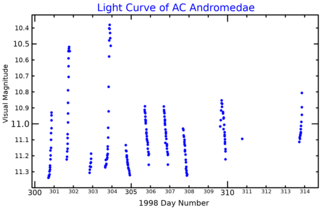
AC Andromedae is a variable star in the constellation Andromeda. Its maximum apparent visual magnitude is 10.77, but can be seen fainter down to a magnitude of 11.9.
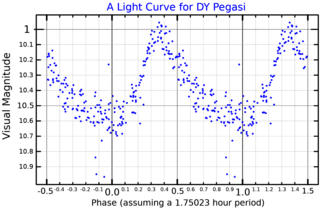
DY Pegasi, abbreviated DY Peg, is a binary star system in the northern constellation of Pegasus. It is a well-studied SX Phoenicis variable star with a brightness that ranges from an apparent visual magnitude of 9.95 down to 10.62 with a period of 1.75 hours. This system is much too faint to be seen with the naked eye, but can be viewed with large binoculars or a telescope. Based on its high space motion and low abundances of heavier elements, it is a population II star system.
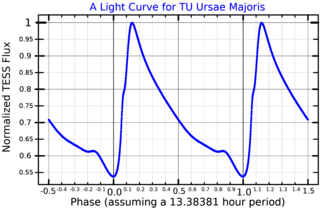
TU Ursae Majoris is a variable star in the northern circumpolar constellation of Ursa Major. It is classified as a Bailey-type 'ab' RR Lyrae variable with a period of 0.557648 days that ranges in brightness from apparent visual magnitude of 9.26 down to 10.24. The distance to this star is approximately 2,090 light years based on parallax measurements. It is located near the north galactic pole at a distance that indicates this is a member of the galactic halo.

SZ Tauri is a variable star in the equatorial constellation of Taurus. The brightness of this star varies from an apparent visual magnitude of 6.39 down to 6.69 with a period of 3.149 days, which is near the lower limit of visibility to the naked eye. The distance to this star is approximately 2,070 light years based on parallax measurements. There is some indication this may be a binary system, but the evidence is inconclusive.

FG Virginis is a well-studied variable star in the equatorial constellation of Virgo. It is a dim star, near the lower limit of visibility to the naked eye, with an apparent visual magnitude that ranges from 6.53 down to 6.58. The star is located at a distance of 273.5 light years from the Sun based on parallax measurements, and is drifting further away with a radial velocity of +16 km/s. Because of its position near the ecliptic, it is subject to lunar occultations.

EU Tauri is a variable star in the equatorial constellation of Taurus. With a brightness that cycles around an apparent visual magnitude of 8.07, it is too faint to be visible to the naked eye. The distance to this star is approximately 3,900 light years based on parallax measurements, but it is drifting closer with a radial velocity of −2.5 km/s. The position of this star near the ecliptic means it is subject to lunar occultations.
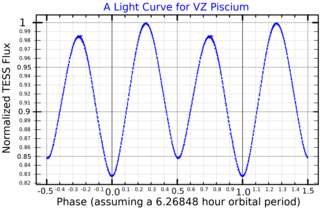
VZ Piscium is a binary star system in the equatorial constellation of Pisces. it is located at a distance of 178 light years from the Sun based on parallax measurements, and has an apparent visual magnitude of about 10.3. This is an eclipsing binary system that undergoes shallow eclipses; the brightness decreases to magnitude 10.45 during the primary eclipse, then to magnitude 10.43 with the secondary eclipse, although as a contact binary the brightness varies continuously with no period of constant maximum brightness. The system is drifting closer with a radial velocity of approximately −4 km/s, and has a net heliocentric velocity of 144.1 km/s.

RR Lyncis is a star system in the northern constellation of Lynx, abbreviated RR Lyn. It is an eclipsing binary of the Algol type; one of the closest in the northern sky at an estimated distance of approximately 263 light years based on parallax measurements. The system is faintly visible to the naked eye with a combined apparent visual magnitude of 5.53. During the primary eclipse the brightness drops to 6.03, while it decreases to magnitude 5.90 with the secondary eclipse. The system is drifting closer to the Sun with a radial velocity of −12 km/s.
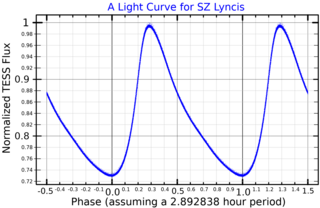
SZ Lyncis is a binary star system in the northern constellation of Lynx, abbreviated SZ Lyn. It is a variable star with an apparent visual magnitude that fluctuates around 9.58, which is too faint to be visible to the naked eye. The distance to this system is approximately 1,700 light years based on parallax measurements, and it is drifting further away with a radial velocity of 34 km/s.

AI Velorum is a variable star in the southern constellation of Vela, abbreviated AI Vel. It is a prototype for a class of high amplitude Delta Scuti variables. The apparent visual magnitude of this star fluctuates around 6.56, which is just bright enough to be dimly visible to the naked eye. The distance to AI Vel is approximately 327 light years based on parallax measurements, and it is drifting further away with a radial velocity of about 9 km/s.
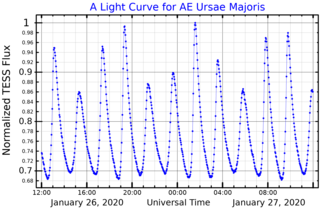
AE Ursae Majoris is a star in the northern circumpolar constellation of Ursa Major, abbreviated AE UMa. It is a variable star that ranges in brightness from a peak apparent visual magnitude of 10.86 down to 11.52. The distance to this star is approximately 2,400 light years based on parallax measurements.
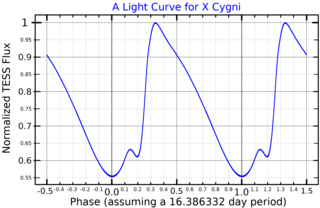
X Cygni is a variable star in the northern constellation of Cygnus, abbreviated X Cyg. This is a Delta Cephei variable that ranges in brightness from an apparent visual magnitude of 5.85 down to 6.91 with a period of 16.386332 days. At it brightest, this star is dimly visible to the naked eye. The distance to this star is approximately 628 light years based on parallax measurements. It is drifting further away with a radial velocity of 8.1 km/s. This star is a likely member of the open cluster Ruprecht 173.




















